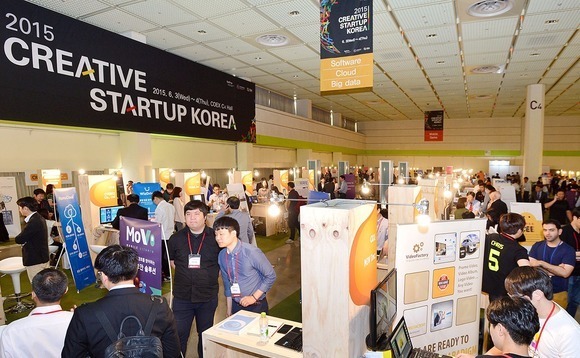
Korea VC fundraising: Unbalanced boom

The forces behind a bumper year for South Korean venture fundraising serve as a reminder that local players must do more to build much-needed international relationships
When Altos Ventures closed its second Korea-focused fund last month at $110 million, it simultaneously represented part of a great wave and a meager trickle. The firm's Korean Opportunity Fund II hit its hard cap - but only about 10% of the corpus came from domestic LPs. While this level of international participation highlights Korea's rising overseas profile as an emerging innovation hub, it is also notable for its rarity as a tangible cross-border commitment in a space dominated by domestic government support.
Around the same time, the Korea Venture Capital Association (KVCA) announced that 2015 was the country's best year to date for venture fundraising. Domestic VCs received KRW2.6 trillion ($2.3 billion) in commitments during the year, up 1.6% on the prior 12 months and 220% better than an anomalous low hit in 2012. The number of funds closed was 110 in 2015, compared to 82 in 2014 and only 54 in 2013.
KVCA attributed the bounce largely to an increased presence of government-backed initiatives such as the Korea Development Bank-managed Growth Ladder fund. This vehicle - along with fund-of-funds managed by the government's Korea Venture Investment Corporation - have come to represent an increasingly indispensable component of local venture fundraising.
"The government has been fairly steady in terms of dishing money out to various firms," says Han Kim, Altos' managing director. "But it knows deep in its heart that in order for the domestic funds to thrive, they need to wean the funds off from direct government money and get the non-government firms involved."
Teething problems
Government-backed fund-of-funds accounted for 24% of 2015's record haul, while Growth Ladder brought in another 9%. By contrast foreign cash inflow during the year represented only 2.6% of local venture fundraising, down from 3.3% in 2014 and in line with annual contributions under 4% since 2007.
The problem with this picture no one really knows if and when a more internationalized and private sector-driven fundraising system - seen as essential to a self-sustaining venture ecosystem - will emerge. Government efforts to incentivize private money into Korean VC through initiatives, such as eliminating penalties on GPs or ramping up support for rookie funds, remain in theoretical planning stages.
Meanwhile, fund manager credibility is a major stumbling block for the latest wave of homegrown VCs seeking foreign and non-government support. "In the last 2-3 years, several VC funds have been set up, but LPs are asking questions about whether they can be sustainable for the next 10 years," says Wonki Yoon, a senior associate at Seoul-based venture firm IMM Investment. "Showing continuity of the business and the track record of the fund - that will be the critical point for fundraising from the non-government side."
AVCJ understands that the government is planning to further increase its participation in venture fundraising this year as part of the drive to create an attractive environment for overseas investors. This means the inputs of Korean VC will likely continue to outweigh the outputs in the foreseeable future. "We are always seeking the equilibrium point between profitability and publicity," a source at KDB says.
Publicity in the Korean VC space these days is good. As government money flows in, expectations for a second boom - to follow up an early-2000s growth spurt - are mounting. Despite the fact that no significant moves to curb the overdependence on government money have materialized and foreign participation for local funds has remained statistically anemic, international buzz for the local entrepreneurial scene continues to amplify.
"Investment has been very active for us," says Bernard Moon, co-founder of SparkLabs Global Ventures, a global seed-stage fund with an affiliated three-month accelerator program in Seoul. "The fifth batch from our accelerator was reflective of the momentum in Korea with nine out of the 12 companies closing a Series A round. During our past two demo days, over 1,500 people attended, primarily from Korea, but throughout Asia, Indonesia, Hong Kong, Singapore and Japan."
The recent successes of SparkLabs and Altos underline the notion that even though foreign investment in Korean VC remains a minor force financially, the sector's most inspiring stories are often those connected to international participation.
"They do like foreign VCs to come in and be the ones who lead investments because that provides a sort of global seal of approval that the start-up has global potential," observes John Nahm, managing director of Strong Ventures, a US firm that has invested in Korean bitcoin exchange Korbit alongside several Silicon Valley-based investors, including Tim Draper. "It provides a sort of badge of honor."
Trust issues
The challenge in generating more cross-border activity of this kind, however, is that a risk-sensitive asset class requires an offsetting element of trust to move forward - and making the necessary personal connections will not be easy.
Altos' Kim says the reason many foreign LPs in Korea are not yet comfortable with pure domestic funds is largely due to a lack of existing relationships. "For a Korean domestic fund to establish international relationships, they have to dedicate quite a bit of time getting to know and meeting with institutional LPs outside of Korea and that's hard given the language and cultural differences. In most Korean venture funds, the main partners don't speak English, which makes it doubly hard."
Any effort to de-provincialize the Korean VC sector will be further complicated by the presence of a small but comfortably accommodating domestic market. Although Korea has a population of only about 50 million people, its start-ups benefit from sweeping, fad-driven consumption patterns and global top-10 rankings in a number of per-capita spending categories such as e-commerce, luxury goods and women's cosmetics.
This setting simultaneously drives intense international interest and a certain complacency among local VC players. The transition from government to non-government fundraising, therefore, will depend not only on attracting more foreign interest in local entrepreneurs but also in reaching outward to a global well of best-practice advice.
"The cultural and mindset change is not easy, but it is coming about," SparkLabs' Moon says. "There are players and accelerators in the ecosystem that get it. They know that it really takes a village to raise a start-up. Everyone needs to chip in to help each other out."
Latest News
Asian GPs slow implementation of ESG policies - survey
Asia-based private equity firms are assigning more dedicated resources to environment, social, and governance (ESG) programmes, but policy changes have slowed in the past 12 months, in part due to concerns raised internally and by LPs, according to a...
Singapore fintech start-up LXA gets $10m seed round
New Enterprise Associates (NEA) has led a USD 10m seed round for Singapore’s LXA, a financial technology start-up launched by a former Asia senior executive at The Blackstone Group.
India's InCred announces $60m round, claims unicorn status
Indian non-bank lender InCred Financial Services said it has received INR 5bn (USD 60m) at a valuation of at least USD 1bn from unnamed investors including “a global private equity fund.”
Insight leads $50m round for Australia's Roller
Insight Partners has led a USD 50m round for Australia’s Roller, a venue management software provider specializing in family fun parks.








